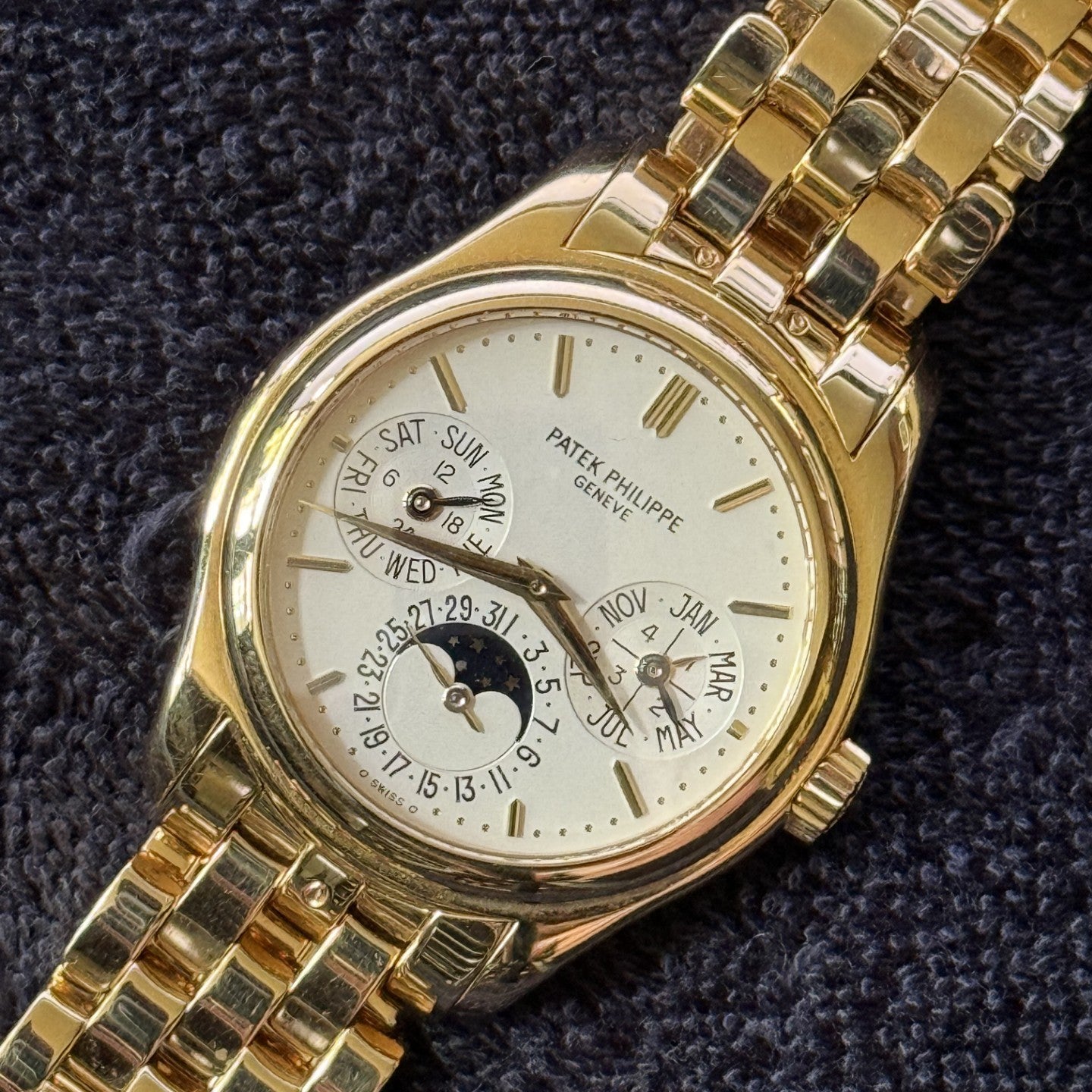
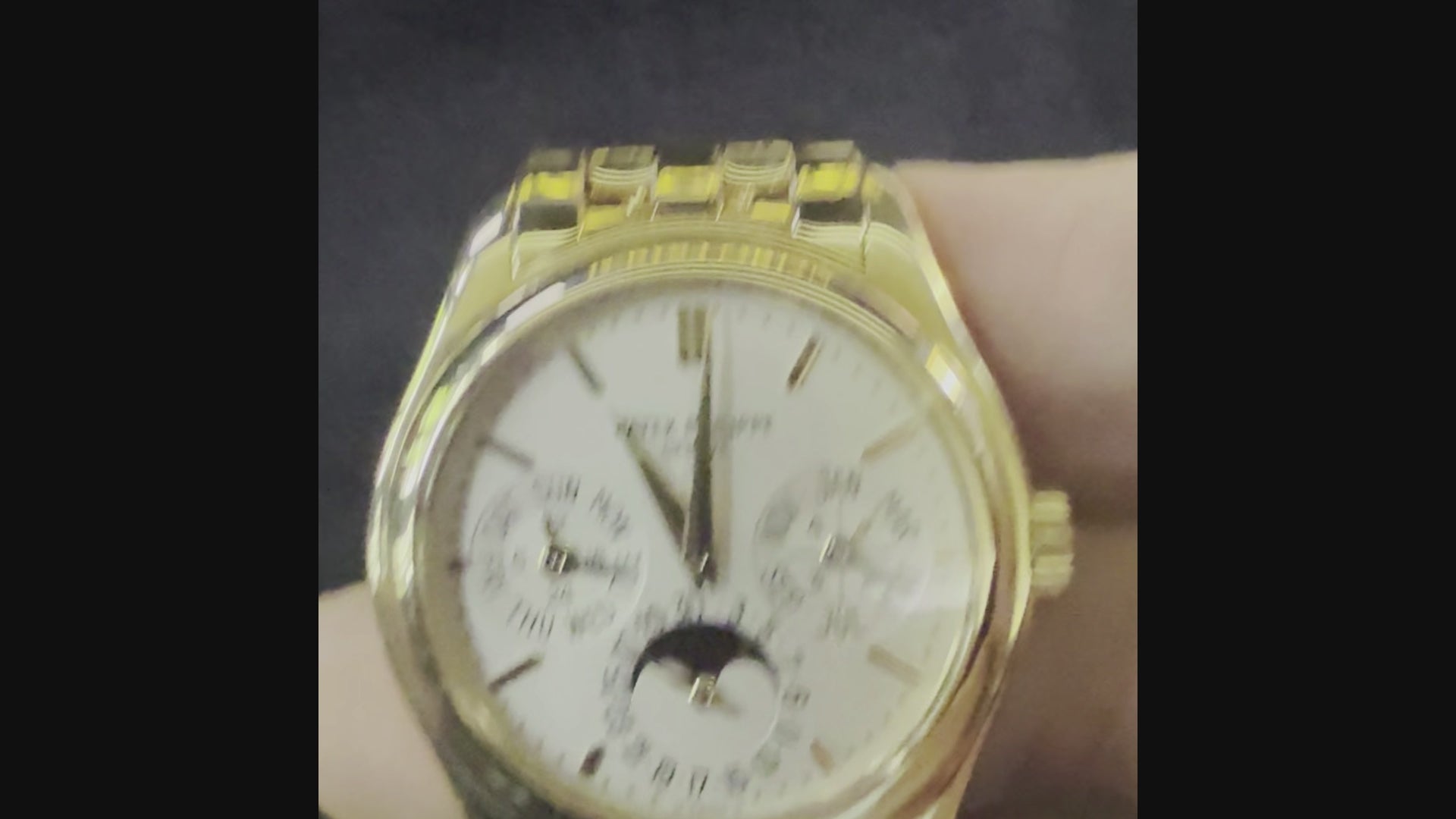
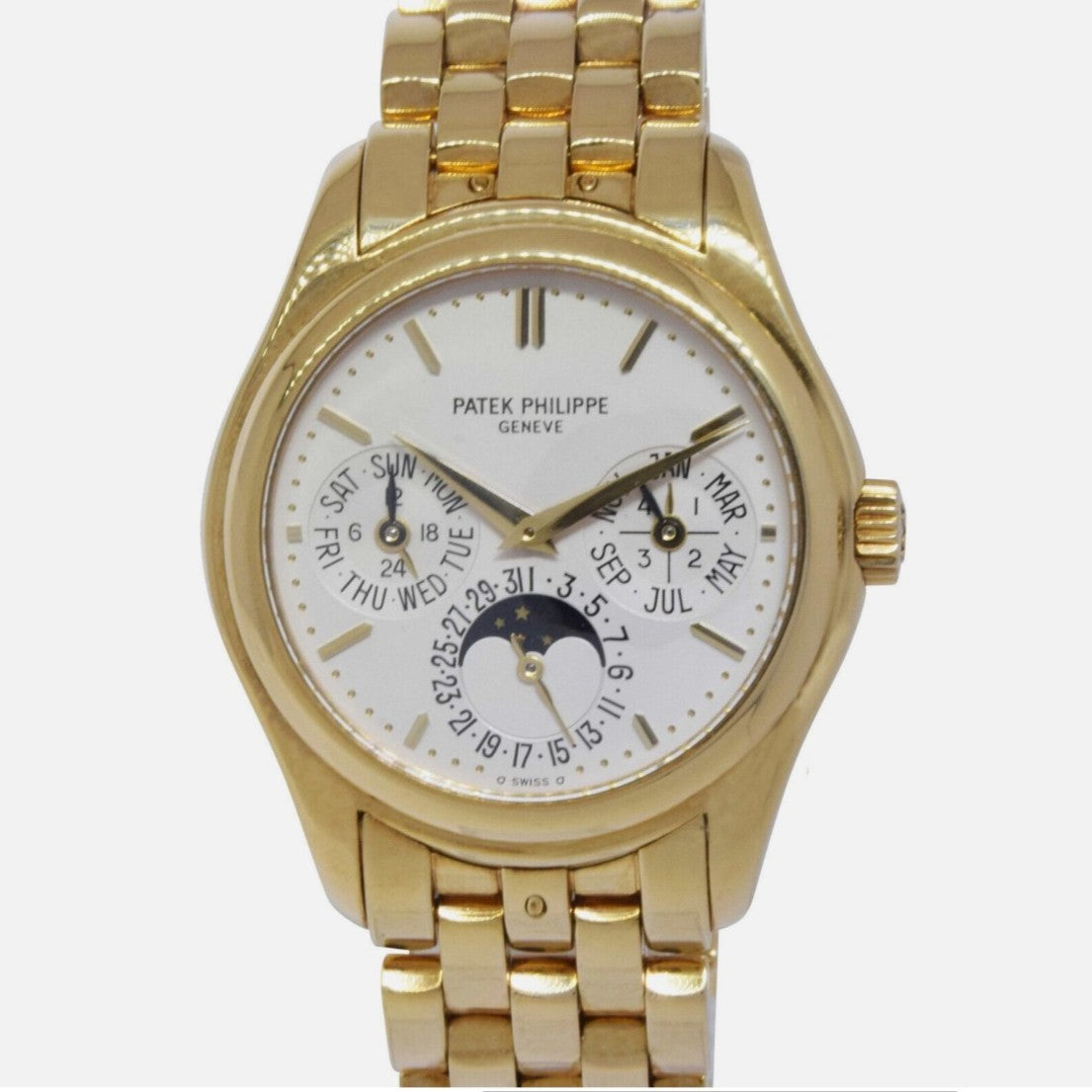
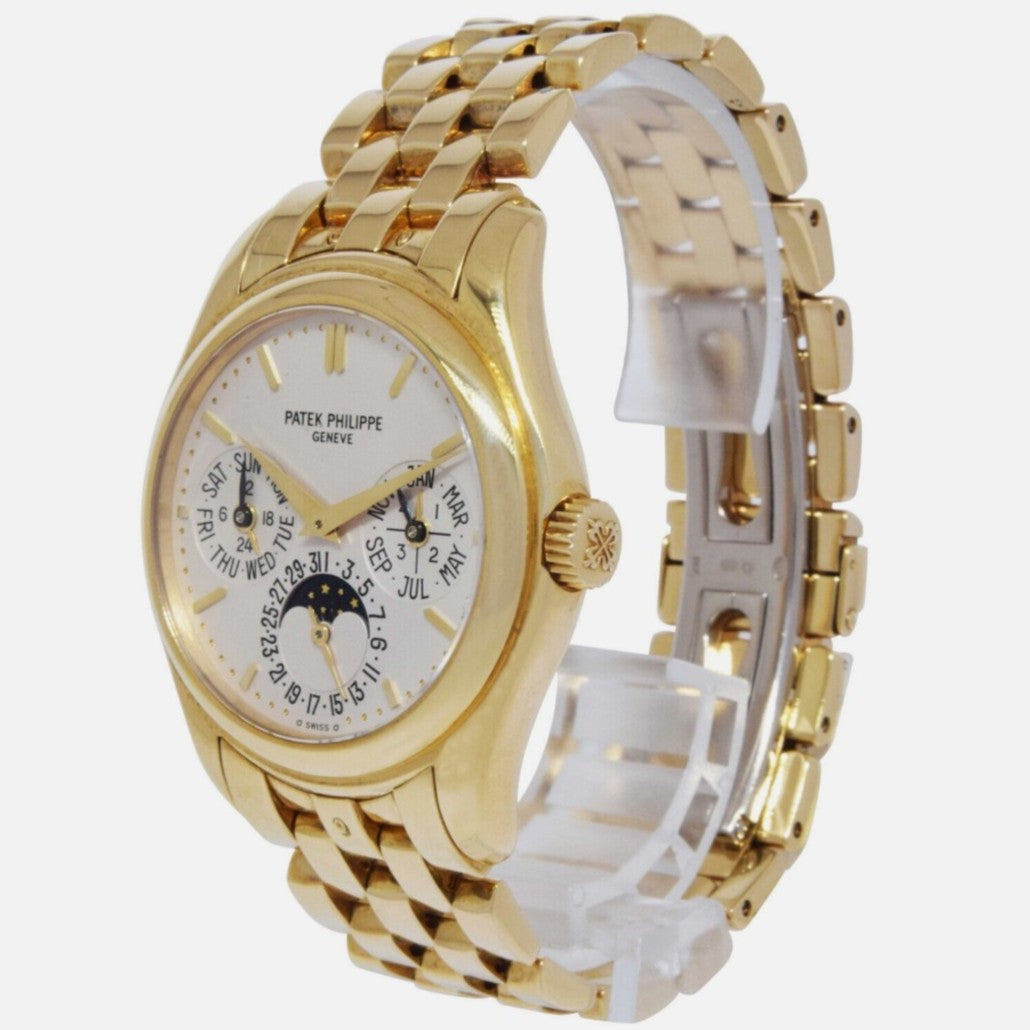
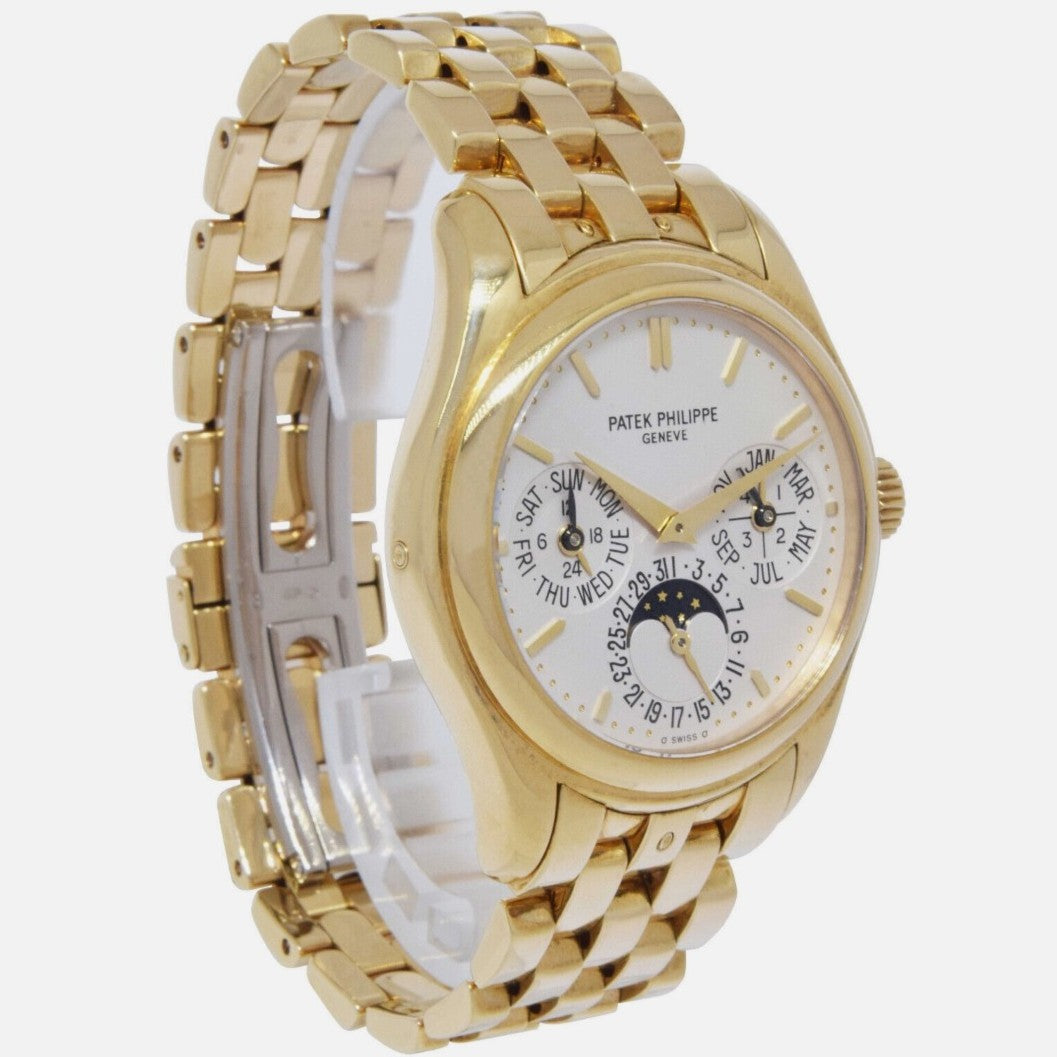
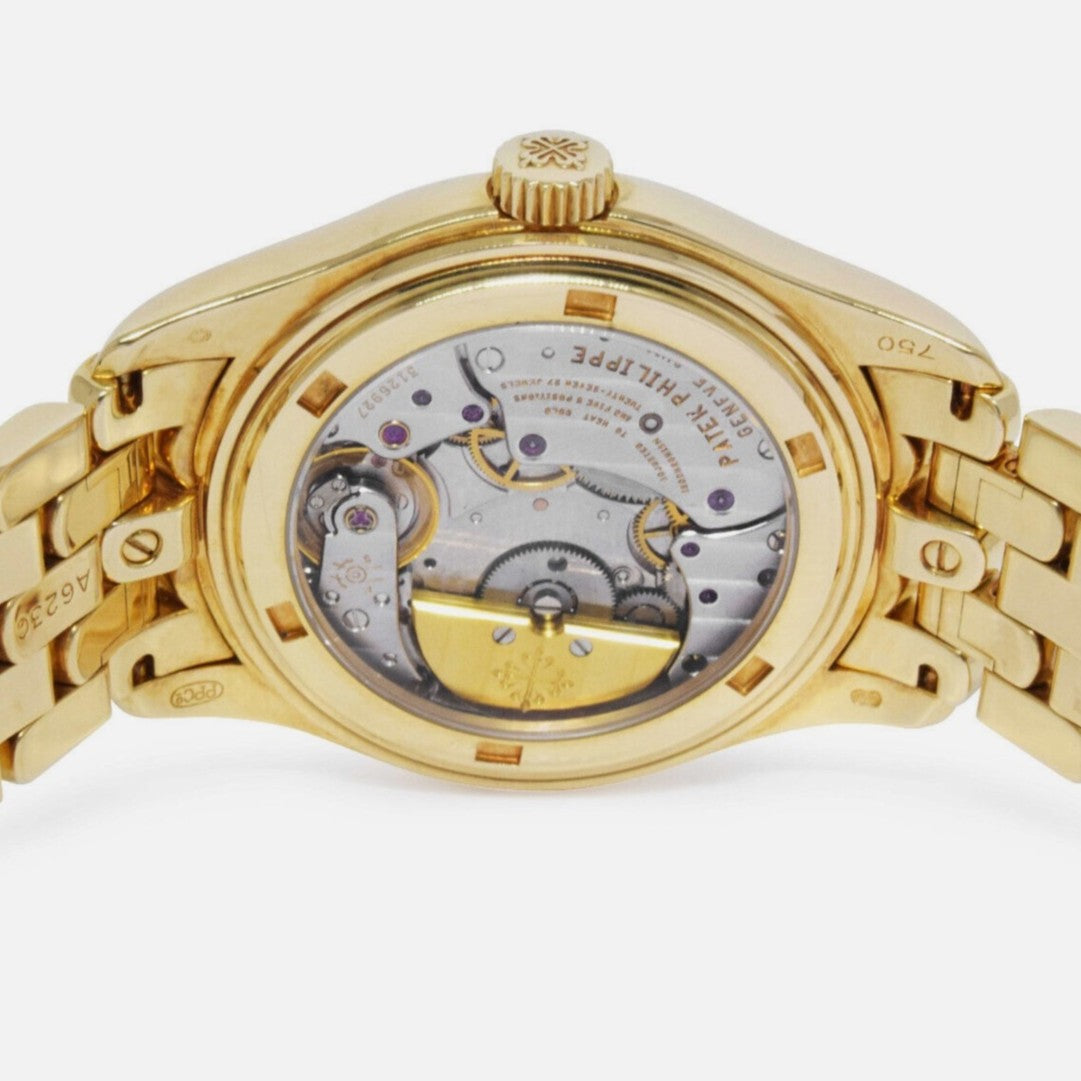
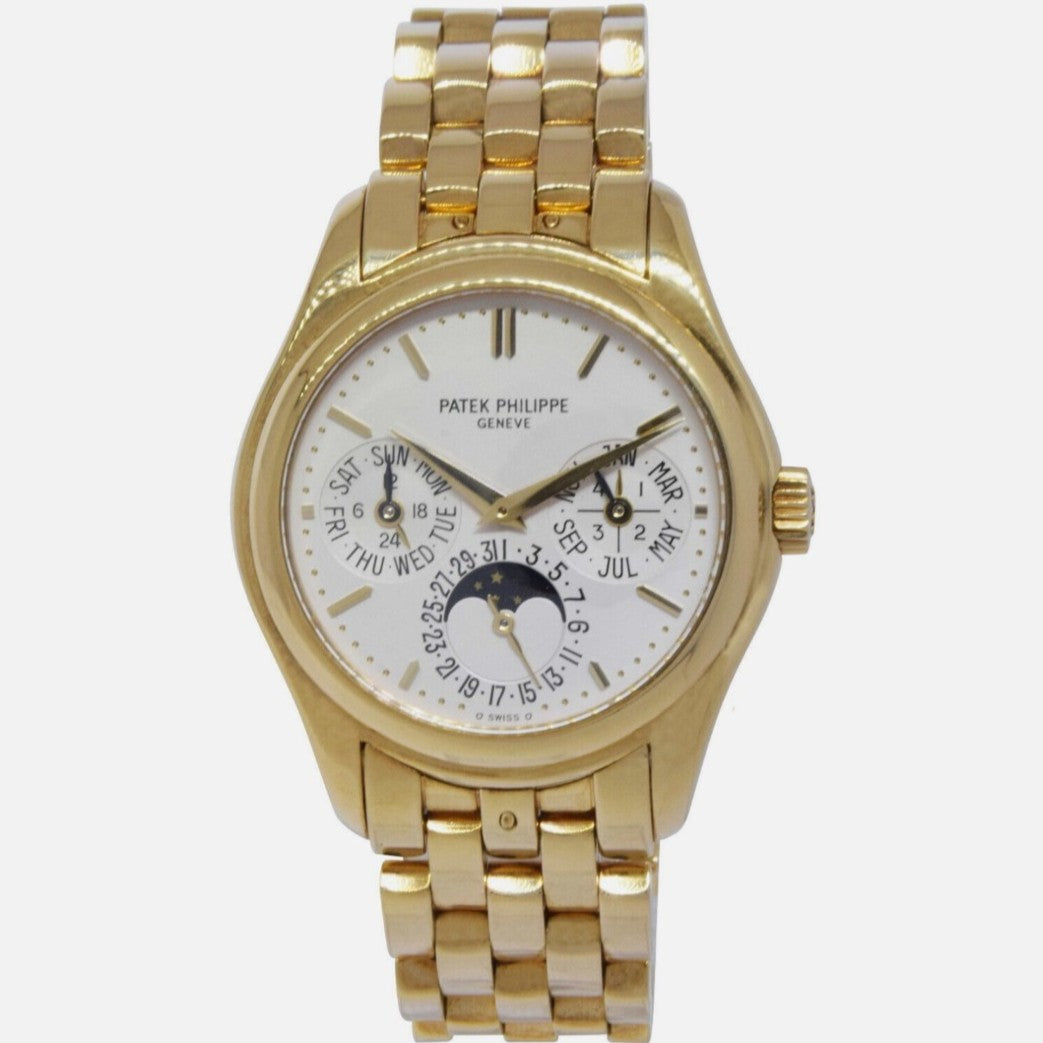
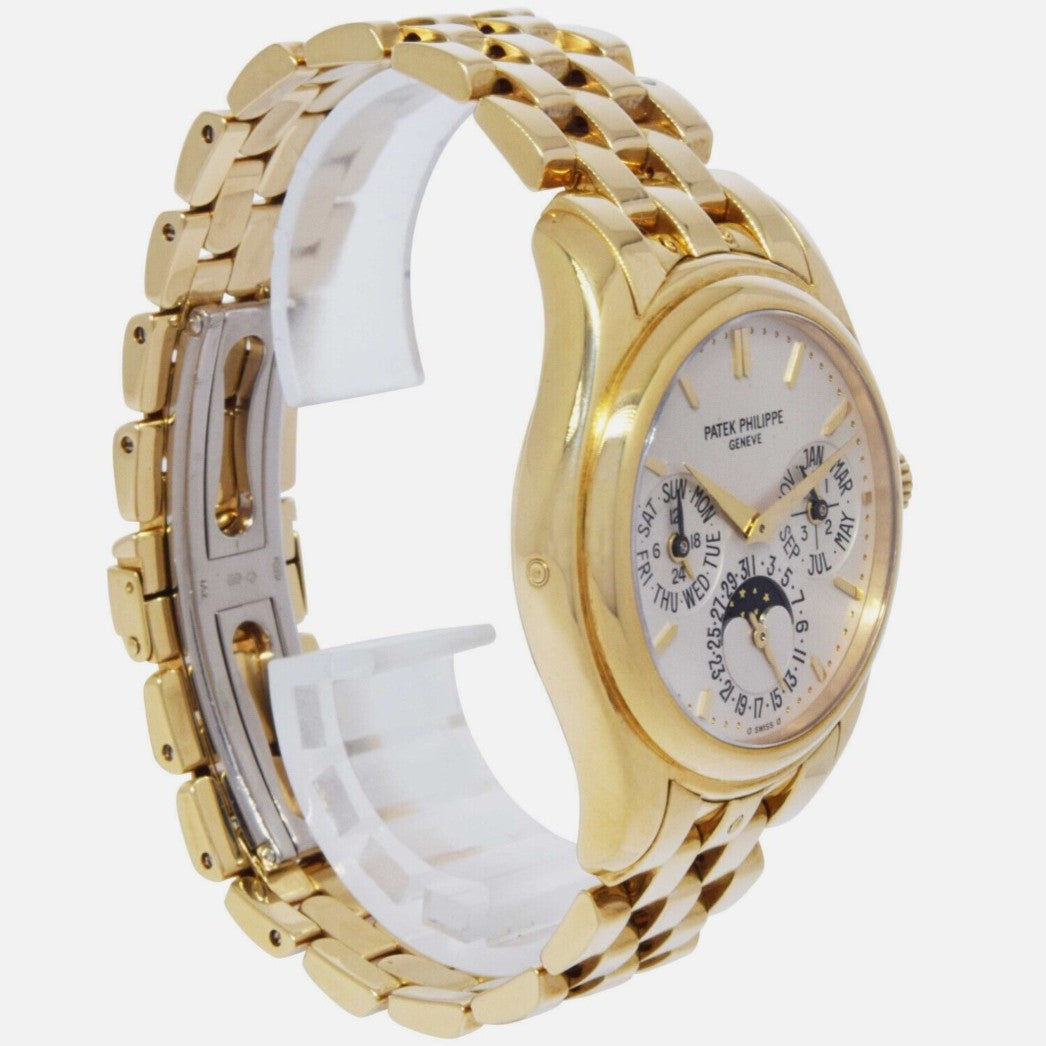
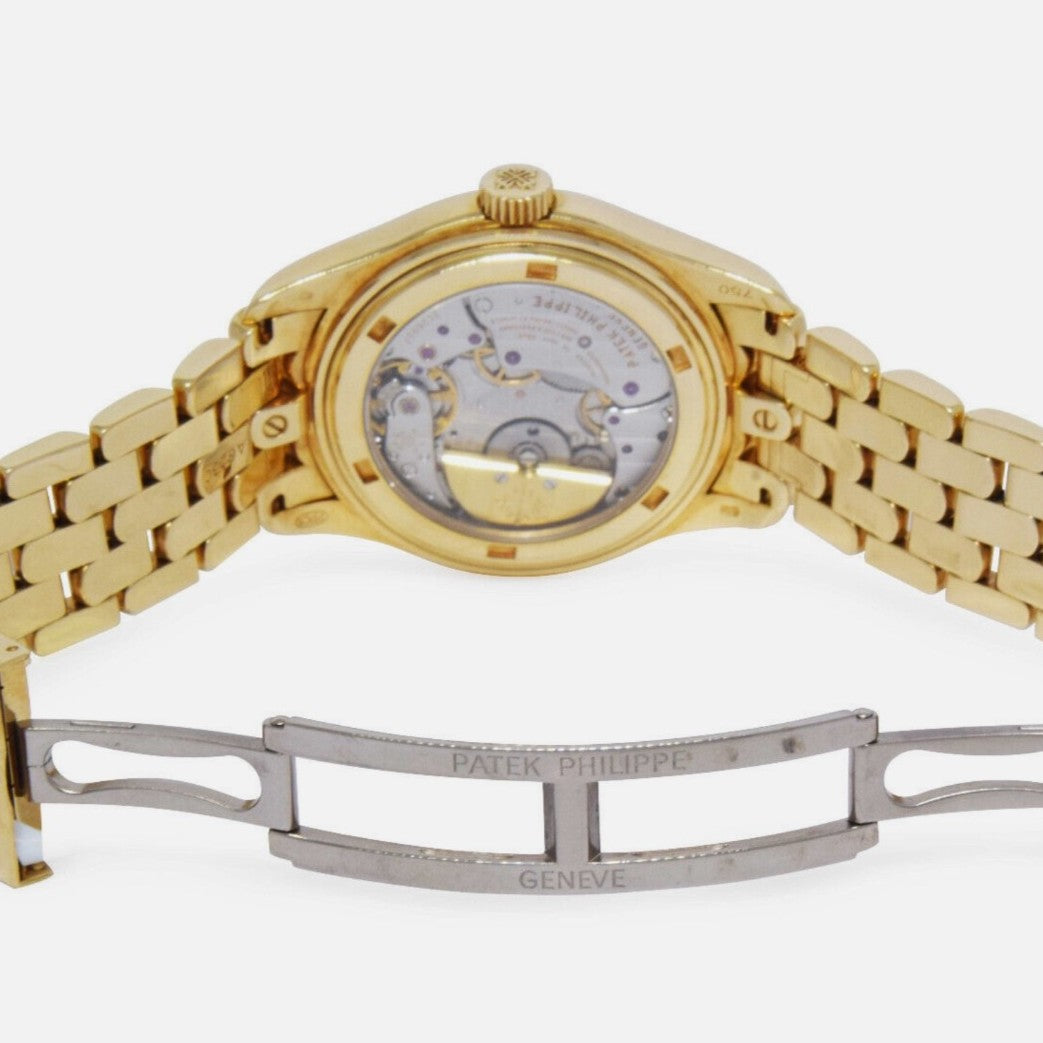
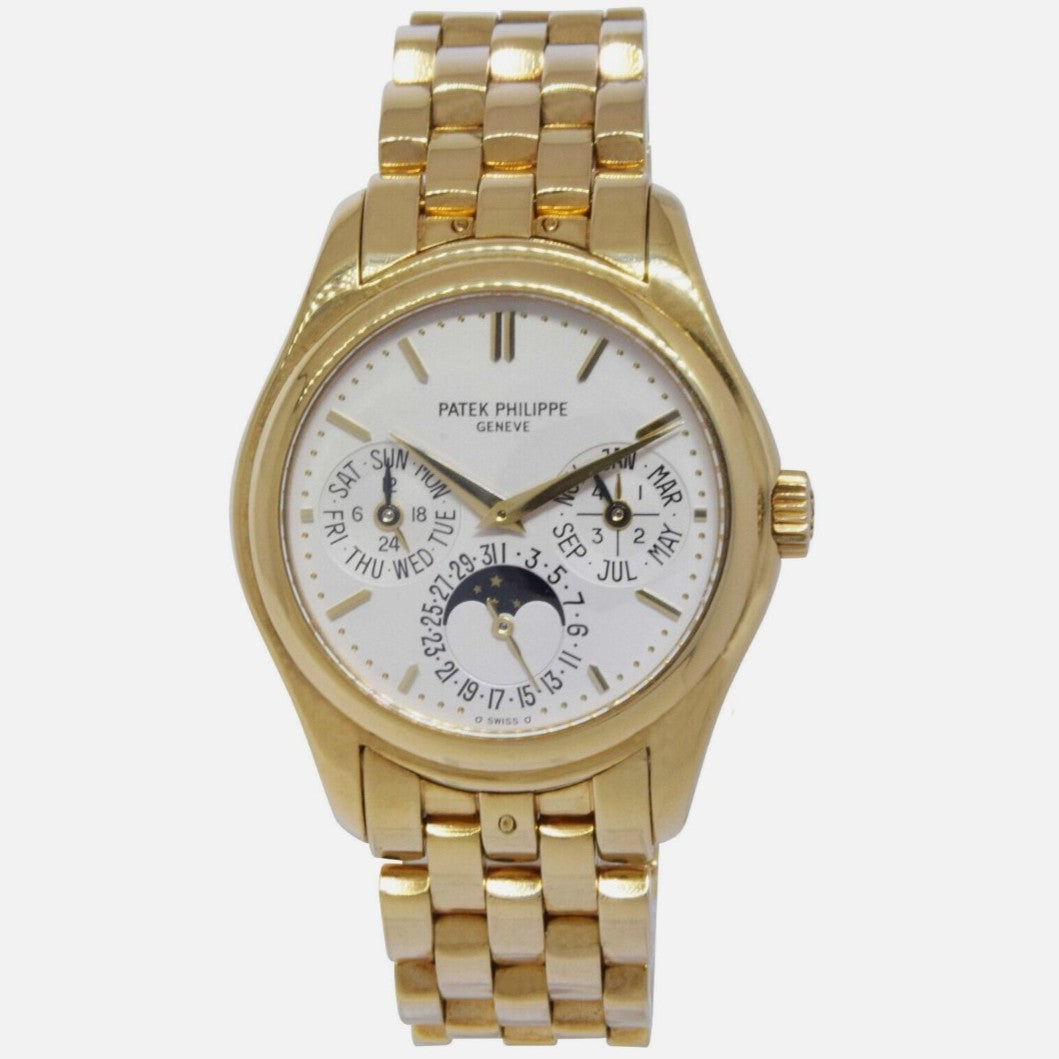
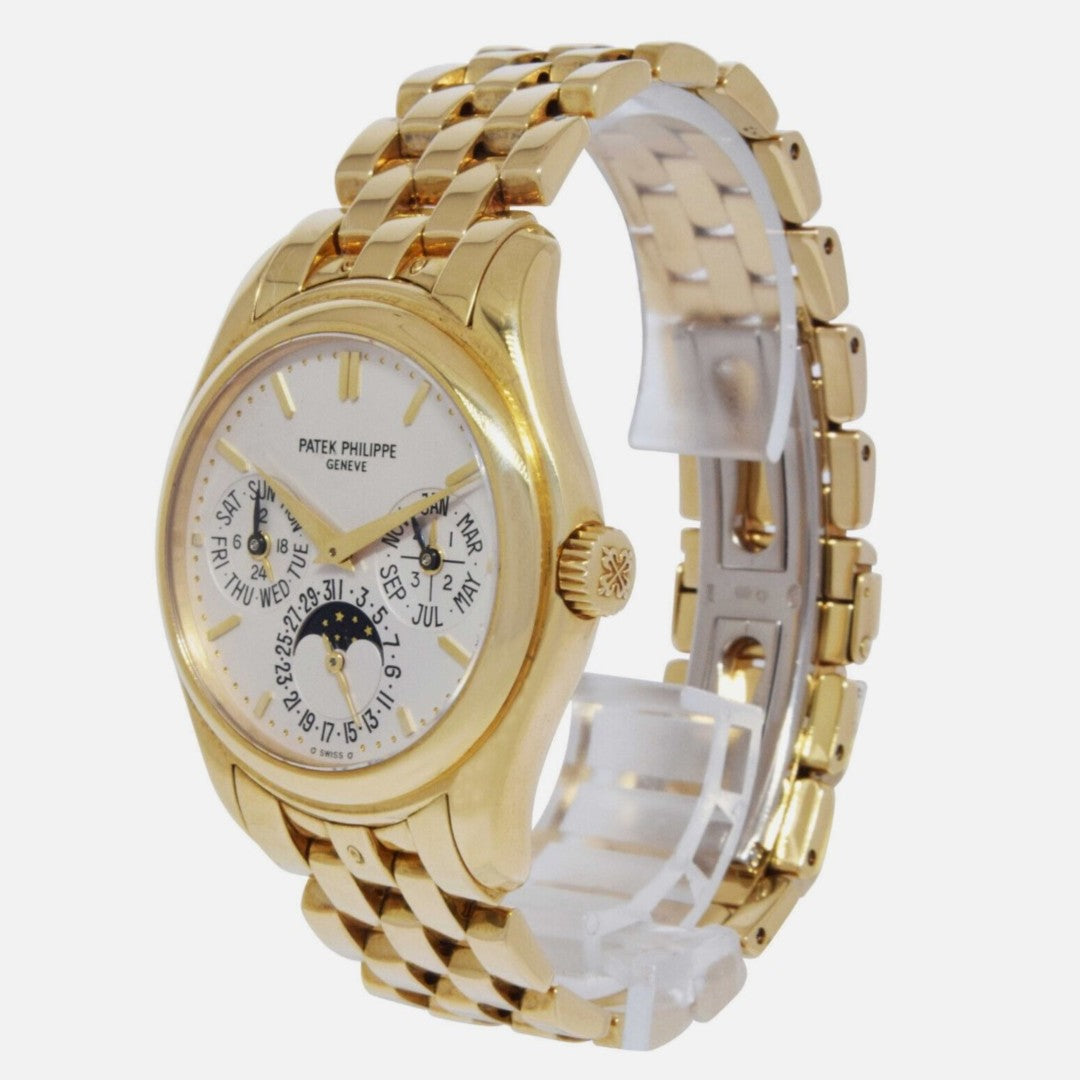
Patek Philippe 5136/1J - 2003 Automatic Perpetual Calendar - Extract
Patek Philippe Reference 5136/1J
Self-Winding Perpetual Calendar with Integrated Yellow Gold Bracelet and Opaline Dial
TECHNICAL SUMMARY
All details are documented and disclosed to the best of our scholarly and technical ability.
I. IDENTIFICATION:
• Brand: Patek Philippe
• Reference Number: 5136/1J
• Case Number: 4’253’503
• Movement Number: 3’126’927
• Unique Features: English calendar display, integrated 18k yellow gold bracelet, fold-over clasp, sapphire display caseback
II. MOVEMENT SPECIFICATIONS:
• Movement Type: Automatic
• Caliber Number: 240Q
• Movement Manufacturer: Patek Philippe
• Complications: Perpetual calendar, date, day, month, leap year indicator, 24-hour display, moon phases
• Jewels: 27
• Frequency (vph): 21,600
• Power Reserve: Approximately 48 hours
• Diameter: 27.5 mm
• Thickness: 2.53 mm
• Water Resistance Per Manufacturer: 25 meters
III. CASE SPECIFICATIONS:
• Case Manufacturer: Patek Philippe
• Case Diameter: 37 mm (excluding crown)
• Case Material: 18k Yellow Gold
• Bezel Type / Material: Fixed / 18k Yellow Gold
• Crystal Type: Sapphire
• Lug Width: 20 mm (integrated bracelet)
• Strap or Bracelet Material: 18k Yellow Gold
• Strap or Bracelet Color: Yellow Gold
• Buckle Type and Material: Fold-over clasp in 18k Yellow Gold
IV. AESTHETIC CHARACTERISTICS:
• Dial Manufacturer: Patek Philippe
• Dial Color: Opaline
• Dial Material: Metal
• Indices: Applied Yellow Gold Sword-Shaped Hour Markers
• Hand Style: Dauphine
• Caseback Style: Sapphire Display
• Engravings: None
V. DOCUMENTATION & ACCESSORIES:
• Original Box: No
• Original Papers: No
• Extract from the Archives: Yes (issued; confirms date of manufacture and sale)
• Other Included Accessories: None
VI. SERVICE HISTORY:
• Last Serviced When: October 21, 2024
• Serviced By Whom: Unknown
• Type of Service Performed: Unknown
VII. CONDITION & AUTHENTICITY:
• Condition Summary: Very Good
• Authenticity: All components verified as original
• Maintenance, Service, or Restoration Disclosure: No known case polishing or dial restoration; limited historical service data; exterior condition suggests responsible care and infrequent wear
VIII. PROVENANCE & PRODUCTION CONTEXT:
• Year of Production: 2003
• Production Period: Manufactured between approximately 2003 and 2008
• Provenance / Ownership History: Not documented
WRISTORIAN’s Perspective:
There’s a quiet clarity in a timepiece that doesn’t feel the need to announce itself. Reference 5136/1J, introduced by Patek Philippe in the early 2000s, did not attempt to reinvent the perpetual calendar. It simply refined it. Seamlessly. Subtly. Completely.
This model emerged as a modern heir to the now-legendary Reference 3940, itself the cornerstone of Patek Philippe’s perpetual calendar lineage since 1985. But where the 3940 expressed itself through a traditional leather strap and a display that emphasized symmetry, the 5136/1J elected for integrated design. Its bracelet is not an addition; it’s a continuation of the case. And in yellow gold, that continuity feels purposeful—monolithic, but never loud.
The case measures 37 millimeters across. By today’s standards, modest. But this timepiece was never meant to overwhelm the wrist. It was designed to honor it.
Inside beats the caliber 240Q, a self-winding movement that balances horological complexity with aesthetic restraint. The “Q” stands for quantième perpétuel—perpetual calendar—and that’s exactly what it delivers: a complication that accounts not just for the months and days, but for leap years, moon phases, and the passage of night and day.
What makes the 240Q such a technical marvel isn’t only what it does, but how it does it. It’s powered by a 22k gold micro-rotor embedded flush within the movement plate, which allows the whole assembly to remain thin—just 2.53 millimeters. This means the 5136/1J retains a sleek profile, slipping easily under a cuff and presenting a silhouette more aligned with classic dress timepieces than complicated ones.
The movement is visible through a sapphire caseback. There, the Geneva stripes, beveled edges, and signature finishing are on quiet display for those who know what to look for. There’s no theatricality—just confidence born of precision.
The dial is opaline. Not white. Not silver. Opaline. It catches light like parchment, with a texture that plays differently at noon than it does at dusk. Applied yellow gold hour markers extend just far enough to structure the dial without interrupting its visual serenity. The English-language subdials are placed at 3, 6, and 9 o’clock for day, date, and month respectively, with the leap year and 24-hour indication subtly nested, and the moonphase placed, quite literally, at the heart of the display.
This is one of those dials that seems to change expression over time. Not because the hands move—though they do, with signature smoothness—but because the light shifts, and your relationship with it deepens.
And then there’s the bracelet. Fully integrated. Sculpted in 18k yellow gold. It wears closer to a cuff than a chain, with a fold-over clasp that vanishes into the form. This bracelet wasn’t designed to complement the case; it was designed with the case. There’s a unity here that feels architectural—more Bauhaus than baroque.
Unlike the 3940 or its successor, the 5140, the 5136/1J was always intended as a bracelet-only offering. That single decision changes the emotional tone of the piece. It’s less intimate, perhaps, but more self-assured. Less tuxedo, more bespoke tailoring.
The reference was introduced in 2003 and remained in production for only a handful of years, concluding around 2008. In that short span, it remained largely under the radar. That’s beginning to change. As collectors now revisit the early 2000s in search of transitional references—those that bridge the purely mechanical past with the refined restraint of modern haute horlogerie—the 5136/1J is being reconsidered. And rightfully so.
Patek Philippe manufactured the movement in-house, of course. The case, also Patek Philippe. The dial likely involved Stern Frères, though by 2003 some dial work had been more fully internalized by Patek’s own workshops. Regardless, the execution remains faithful to the classical proportions, legibility standards, and understated beauty that defines the brand’s golden period of calendar timepieces.
There’s no engraving on this example. No initials. No dated inscriptions. And no dramatics. The condition is, by WRISTORIAN standards, “Very Good.” That is to say: original throughout, well-kept, sympathetically worn, and responsibly serviced. We do not polish indiscriminately, and we do not embellish originality. What remains here is honest—visibly, technically, and horologically.
It should be said plainly: this is not a museum piece. Nor is it meant to be. This is a daily calendar for the connoisseur who prefers quiet mastery to overt display. Its service history is partial. Its accessories are absent. But what it offers—the engineering, the execution, the emotional restraint—is very much intact.
What emerges is a study in balanced contrast. Thin but solid. Complicated but calm. Traditional but not vintage. The 5136/1J is the sort of timepiece that resists epiphany but rewards attention. It doesn’t insist on itself. But spend time with it, and its integrity becomes impossible to ignore.
Integrated elegance. Mechanical depth. Nothing overstated—everything considered.
Each WRISTORIAN timepiece is delivered with understated elegance, a rigorous scholarly dossier, and a clear account of its condition, originality, and any prior intervention, to the extent permitted by available evidence and expert review.
Choose options











